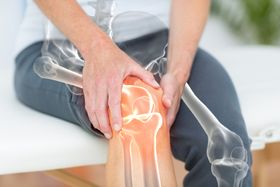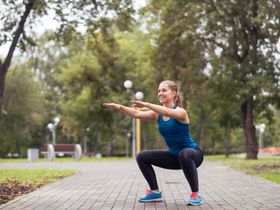Low Impact vs High Impact Exercises: Which One is Right for You?
Published May 30, 2023.

When it comes to exercise, we all have different goals in mind. Some of us aim to increase endurance, others strive for weight loss, while some focus on building muscle strength. As an Olympic athlete, I've dedicated my life to fitness and understand the importance of exercise in leading a healthy lifestyle.
However, with different goals come different types of exercises. Some seek the invigorating rush of high-intensity workouts, while others prefer a gentler approach that takes into consideration joint health and overall well-being.
So what are high-impact exercises, and what are low-impact exercises? Let's find out!
What's the Difference?
High-impact exercises encompass movements that place a substantial level of stress on your joints, often involving jumping and other intense activities. On the other hand, low-impact exercises gradually elevate your heart rate while putting minimal pressure on your joints.
Did You Know?
The type of surface you exercise on can influence the impact level. Grass and dirt paths tend to have a lower impact compared to concrete or asphalt.
» Find out how your clothing affects your performance
Benefits of High-Impact Exercise
High-impact exercises offer a range of benefits that make them an appealing option to many people. They are great for cardiovascular conditioning as they elevate your heart rate and help improve your overall endurance. Furthermore, high-impact exercises contribute to the health of your bones, as they help improve bone density and reduce the risk of osteoporosis and fractures.
Another appealing aspect of high-impact workouts is that they're usually much shorter while still providing full fitness and health benefits. The intensity of these exercises allows you to maximize your efforts and burn calories efficiently. High-impact exercises are also great for strengthening your muscles, as they typically involve weight-bearing movements that engage a large number of muscle groups, promoting overall muscular development and tone.
Here are some examples of high-impact exercises:
- Running: A classic high-impact exercise that can be easily incorporated into your routine.
- Tennis: A dynamic sport that involves quick movements and intense bursts of energy.
- Skiing: A challenging activity that engages multiple muscle groups while providing an exhilarating experience.
- Gymnastics: A sport that demands strength, flexibility, and precision through various jumps and flips.
Best for:
High-impact exercises are best suited for people who are seeking effective calorie-burning workouts and want to strengthen their muscles. The high-intensity nature of these exercises helps elevate heart rate and boost metabolism, making them ideal for those aiming to shed excess weight and improve overall fitness.
Remember to start gradually and listen to your body to prevent overexertion or injuries.
Benefits of Low-Impact Exercise
Low-impact exercises offer numerous advantages, making them an excellent choice for individuals who prefer a gentler approach to fitness. Here are some benefits of low-impact exercises:
- Reduced chance of injury: Low-impact exercises put less stress on your joints and muscles compared to high-impact activities, lowering the risk of injury. It is still important to maintain proper form and technique while performing these exercises, along with focusing on proper breathing, to ensure a safe and effective workout.
- Enhanced flexibility: Engaging in Low-impact exercises contribute to improved flexibility and reduced stiffness in the body. Whether it's through Pilates, yoga, or dedicated stretching routines, these exercises increase joint range of motion, promoting flexibility and mobility. Regular practice can lead to greater ease of movement and improved overall flexibility.
- Better mental health: Activities such as walking, which is a popular low-impact exercise, have been shown to benefit mental health by reducing the risk of depression and anxiety. Low-impact exercises provide an opportunity to clear your mind, boost your mood, and increase energy levels, contributing to improved mental well-being.
- Weight loss: Contrary to popular belief, low-impact workouts can still be effective and contribute to weight loss. While they may not burn calories as rapidly as high-impact exercises, they offer a sustainable and manageable way to burn body fat. Consistency and proper intensity are key to achieving weight loss goals with low-impact exercises.
Some examples of low-impact exercises include:
- Pilates
- Golf
- Swimming
- 7-Minute workout
» Learn how exercise can help you sleep better
Best for:
Low-impact exercises are ideal for people with joint conditions or injuries. These gentle exercises can help you maintain your fitness without causing further damage. For those accustomed to high-impact training, incorporating low-impact exercises can provide a refreshing break and prevent overtraining.
Moreover, if you're new to working out, starting with low-impact exercises can be a safe and effective way to build fitness. Similarly, if you're recovering from an injury, low-impact workouts can play a crucial role in gradually rebuilding your strength without overstraining your body.
Pro Tip: The right shoes can make a significant difference. Especially for high-impact exercises, wearing shoes with good cushioning and support can help reduce the impact on your joints.
Striking the Balance
Choosing between high and low-impact exercises isn't always an either-or situation. Both can offer unique benefits in supporting your fitness and weight loss goals. High-impact exercises can bring quicker results and enhance cardiovascular health, while low-impact ones protect joint health and offer a sustainable approach to fitness.
Your choice ultimately depends on your personal fitness goals, current health conditions, and enjoyment. You might even opt to blend both into your routine for a balanced approach. For instance, the 7-minute workout is an excellent low-impact workout that can be easily integrated into your busy schedule. It supports weight loss, improves overall fitness, and is gentle on the joints.
Remember, the journey to fitness isn't a sprint but a marathon. No matter what path you choose, consistency, enjoyment, and a balanced approach are key. So lace up your sneakers and give it a try!





